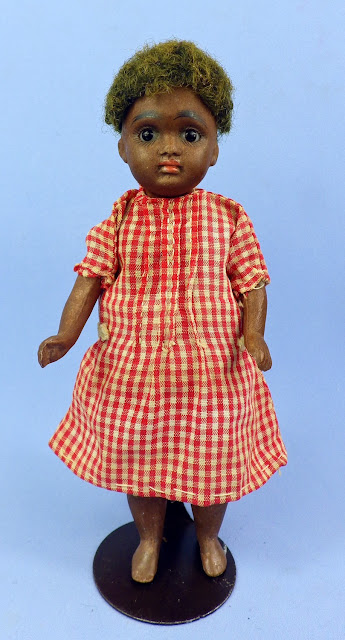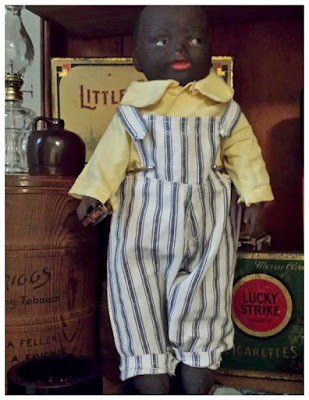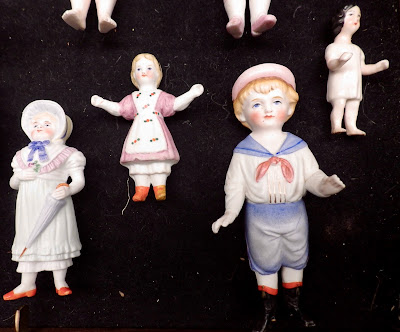This 9-inch tall little boy is from the collection of member Jenell Howell. He is by Heubach Koppelsdorf and has a bisque head on a composition body. Dressed in what might be his original bellhop outfit, he likely dates from 1919 to 1932.
dollshow

AUSTIN DOLL COLLECTORS SOCIETY
The Austin Doll Collectors Society is an organization of antique, vintage, and modern doll collectors, dealers, and artisans. We meet on the second Sunday of each month and our meetings are fun and educational. We begin with refreshments and socializing, and, following our brief business meeting, there is a special doll-related program and "show and tell." The Austin Doll Collectors Society is a nonprofit organization and is a member of the United Federation of Doll Clubs.


Wednesday, February 28, 2018
Tuesday, February 27, 2018
Black History Month; Another All-Bisque Girl
This 6-inch tall barefoot all-bisque doll is attributed to Kestner. The wig is original and the dress old.
Monday, February 26, 2018
Black History Month; S.F.B.J. Lady
This Black lady doll belongs to member Myna Loesch. This lovely lass is approximately 10 inches tall with a composition body and bisque painted head. She may have been clothed to represent Martinique (her turban is replaced). The maker is Société Française de Fabrication de Bébés et Jouets, known by its initials "S.F.B.J." In 1899 the remaining French doll manufacturers joined together to form S.F.B.J. in an attempt to survive competition by German doll makers.
Sunday, February 25, 2018
Black History Month; Hanna
This tropical tot is Hanna by Schoenau and Hoffmeister. She is all original and is 7.5 inches with a fired bisque complexion. Hanna came in her original box with the palm tree, which is stamped "Germany" on its composition base. She is incised "Hanna" on the back of her head, as well as with the Schoenau mark of a "S" and "H" separated by a star.
Friday, February 23, 2018
Black History Month; South African Zulu Doll
This beautiful doll is from the collection of member Sylvia McDonald and represents a woman from the Zulu tribe. She is made of stuffed felt and elaborately decorated with amazing beadwork, for which the Zulus are famous. The Zulu tribe is one of the several tribes in South Africa. These distinctive dolls were made in the 1950’s and 1960’s by Zulu women at the Red Cross Rehabilitation Center in Durban, South Africa.
Wednesday, February 21, 2018
Black History Month; Cotton Joe
This is Cotton Joe from the collection of member Myrna Loesch. He was made by the Horsman Company from 1910 to 1916. Joe is 10 inches tall with a "Can't Break Em" composition brown head with painted features, hard stuffed tan cloth body, and olive cloth legs. He came wearing a red or striped shirt with brown or khaki suspender pants; some may have had a straw hat and was one of the original American Kids in Toyland series. This example has replaced clothes and repainted facial features.
Tuesday, February 20, 2018
Black History Month; All-Bisque Doll by Simon and Halbig
Continuing our showcasing of Black dolls for Black History Month, this 9 inch tall all-bisque doll is attributed to the German company of Simon and Halbig. She wears her original red and ecru striped knee length knit swimsuit with ecru ribbon straps, black knit socks and black leatherette slippers on her bare feet, and is marked "4/886" back of her head.
Monday, February 19, 2018
Black History Month; Meet Jada
This adorable African-American girl is from the collection of member Sylvia McDonald. Her name is Jada and she was created by artist Helen Kish as a friend for Kish's Riley doll.
Sunday, February 18, 2018
Black History Month
The Association for the Study of Negro Life and History (ASNLH), an organization dedicated to researching and promoting achievements by African-Americans, sponsored a national Negro History week in 1926. Schools, churches, and communities would organize local celebrations and lectures. Cities began issuing proclamations recognizing Negro History Week and by the 1970s college campuses began designating February as Black History month. In 1976, as part of America's bicentennial, President Gerald Ford officially recognized February as Black History Month. Black dolls are an important part of doll history, so in commemoration of Black History Month, our club will be sharing examples of Black dolls. This 7 inch tall wax doll of an African-American woman selling chickens was created in New Orleans by the Vargas family. The patriarch of this artistic family was Francisco Vargas. He was born in Mexico, where he had been trained in making wax religious sculptures. Francisco immigrated to the United States and in 1875 set up a shop in New Orleans selling his wax sculptures. Instead of religious images, Vargas created realistic looking flowers, fruits and human figures. The Vargas figures are made of beeswax and dressed in fabric that had been dipped in hot wax and draped over the doll. His children and grandchildren continued the family tradition up through 1930s. Many of the figures were sold as souvenirs and are based on vendors seen on the streets of New Orleans. Under her base, a black and silver label reads “Harriet’s 318 Royal Street New Orleans.”
Wednesday, February 14, 2018
February 5, 2018, Meeting
For our February meeting, the refreshment able was decked out in a festive Mardi Gras theme.
Member Sharon Weintraub did a program on frozen Charlottes and Charlies. These unjointed bisque and china children are typically frozen into a standing position. Early doll collectors dubbed these dolls "Frozen Charlottes" after the the old American folk ballad called “Fair (or sometimes Young) Charlotte,” which tells the sad tale of a beautiful young woman who foolishly refuses her mother's advice to dress warmly and subsequently freezes to death on a sleigh ride to a Christmas Eve ball. However, these figurines are actually German in origin, where they were called badekinder (bathing children). Produced in Germany beginning in the 1860s, they were offered as children’s playthings and bath toys (some, like the little boy at the top left in yellow and white striped bathing trunks will actually float when placed in water).
The little girl on the left is a bank with a slot on her back for coins. Not too many seem to have survived, because the only way to reclaim your savings is the literally break the bank!
Although many badekinder are nude, they also can be found in molded clothing.
Some frozen Charlottes wore wigs.
Frozen Charlottes also appear in novelty items, such as this the badekinder in a bottle.
This early china Charlotte is beautifully dressed an antique bridal gown of silk and net. Sometimes a doll would be dressed a scraps left over from making the bridal gown to commemorate the happy occasion.
Other members brought Frozen Charlottes to share. This diminutive doll belongs to Beverly Evans.
This tiny child is a family heirloom belonging to Elaine Jackson.
Sylvia McDonald brought this bisque-headed baby character by the Japanese firm of Morimura for show and tell.
Subscribe to:
Comments (Atom)





















